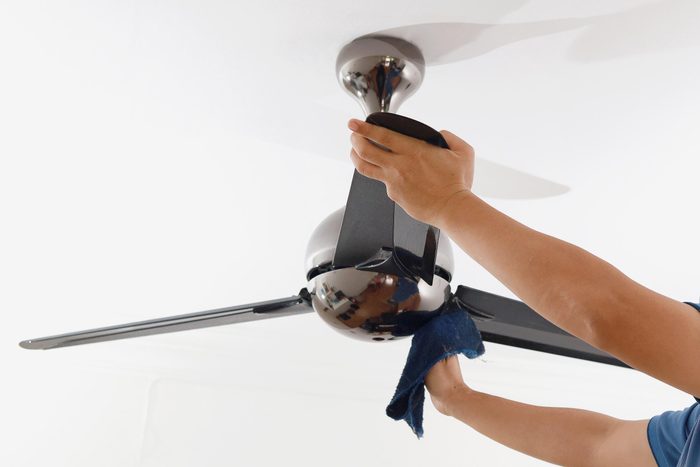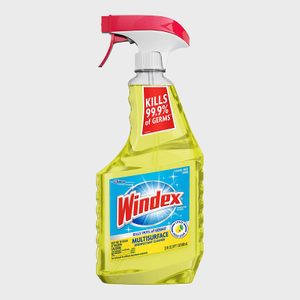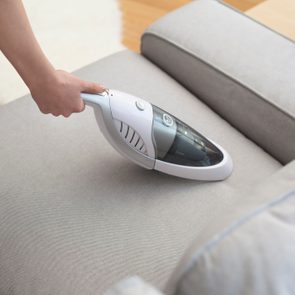How to Clean Ceiling Fans Quickly and Easily
Updated: Jun. 07, 2024

Create a healthier, happier home by learning how to clean ceilings fans safely and effectively
Ceiling fans are a great way to cool your place in summer, lower energy bills in winter and add interest to a room all year long. But by their very nature, they are hard to clean. Fortunately, experts are more than willing to share how to clean ceiling fans safely and quickly. We’ve asked a few of the pros for insider tips that’ll help you expand your cleaning schedule and identify the best cleaning supplies for each situation.
In fact, an old pillowcase works wonders as the perfect tool to keep ceiling fans tidy between cleanings, says Walter E. Bennett, a handyman with Green Leaf Air. “Slip a clean pillowcase over each blade and then wipe it down,” he says. “The dust and dirt will collect inside the pillowcase, making cleanup a breeze.”
Of course, this is just one way to get rid of dust accumulating on the ceiling fan. Like cleaning your kitchen or popcorn ceilings, there are several different steps for how to clean ceiling fans. Read on for expert-approved steps and insider advice.
Get Reader’s Digest’s Read Up newsletter for more cleaning, humor, travel, tech and fun facts all week long.
How often should you clean ceiling fans?
Clean a ceiling fan once every three months, says Karina Toner, operations manager at Spekless Cleaning. And consider that a matter of health.
If they’re not cleaned regularly, fans will accumulate dust and dirt that can adversely affect people with asthma, allergies and other respiratory conditions. Not only will dust collect on the blades, but the fan will also spread allergens throughout the room, making your home unhealthy.
Other problems can arise as well. “Dust and dirt can accumulate on the blades and in the crevices of the fan housing, causing the fan to work less efficiently. Heavy dust buildup can also potentially be a fire hazard if the motor overheats,” Toner points out.
The good news is, there are plenty of signs that’ll let you know when it’s time to clean your ceiling fan. First, look for the obvious dirt and dust buildup. An additional, though less apparent, sign is dirty air vents. “This indicates that the fan is circulating polluted air, which can have negative health consequences,” says Bennett.
Be sure to listen for clues too. “If your ceiling fan is making more noise than usual, it could be due to a buildup of dirt and dust on the blades,” he says.
How to clean ceiling fans
Before you learn how to clean ceiling fans, collect a few different tools. A stepladder is one of the most vital. “Do not be tempted to use a chair instead of a stepladder,” cautions Ana Andres, co-founder of Tidy Choice. “Most home accidents are caused by people falling from chairs.”
Invest in a good stepladder for this task, then gather the rest of the tools you need to get the job done.
Supplies:
Step 1: Prep the area
Safety first! Make sure the fan and light bulbs are completely turned off and the fan has come to a complete stop before attempting to clean it.
“You can also lay down tarps on the floor, carpet and furniture in the room to protect them from stray dust and dirt falling from the fan,” Andres points out. That way, you won’t have to play Pine-Sol Lady and clean your floors to mop up the fallen dust.
Next, set up your stepladder, making sure it is steady and won’t move as you clean the ceiling fan. As a final step, make sure the area is well ventilated by opening a window. (While you’re in the cleaning mood, go ahead and clean your windows. Like ceiling fans, drapes and blinds collect a lot of dust, so give those a dusting too.)
Step 2: Clean the blades
Now you’re ready to start cleaning. “Use the microfiber cloth to remove any loose dust or dirt from the blades,” says Bennett. Stay at the base of the fan and work your way out toward the end of the fan blade. Complete this process for each blade.
Step 3: Add all-purpose cleaner
For stubborn dirt or grime, apply an all-purpose cleaner to the microfiber cloth. If you prefer to use a natural cleaner, mix up a DIY version: Combine equal parts water and white vinegar in a bottle, then spritz it on the cloth. “But be sure to use only enough to make the microfiber cloth slightly damp, so as not to cause any damage to the fan’s motor,” Toner says. Too much cleaner can damage the engine parts of the ceiling fan.
Gently wipe your fan blades—no waiting necessary. “Unless there is heavy grime buildup or stubborn stains, you often won’t need to have cleaning products sit for long on the blades while cleaning,” she says.
Take care with the blades. Avoid bending them, which will damage the ceiling fan and prevent it from efficiently circulating air in the future.
Step 4: Wipe down the housing
How to clean ceiling fans shares some similarities with how to clean walls and how to clean tile floors—namely, you don’t want to use too much liquid. If your cleaning cloth is still damp, there’s no need to add more cleaning solution.
But if your cloth dried during the prior steps, start by dampening it again. Then wipe down the housing and any other visible parts of the fan, says Bennett.
Step 5: Dry the fan
Finally, use a fresh, dry microfiber cloth to remove any excess moisture and dry the fan thoroughly. This quick rundown is the perfect final touch and the end of your lesson on how to clean ceiling fans.
The best ceiling fan cleaners
When it comes to store-bought cleaning products, Bennett recommends Lysol Multi-Surface Cleaner or Windex Multisurface Cleaner to effectively remove dirt and grime from ceiling fans. “However, follow the manufacturer’s instructions and use these products in a well-ventilated area,” he cautions. “Overall, we recommend using natural cleaning solutions for ceiling fans whenever possible to minimize exposure to harsh chemicals. Mixing white vinegar and water is an effective and safe option for keeping your ceiling fans clean and tidy.”
How to keep ceiling fans clean
To keep your ceiling fans tidy between deeper cleans, use Bennett’s pillowcase cleaning tip to dust the blades with no muss and no fuss. Another great tip from Bennett is to periodically alternate the direction of your ceiling fan. “This can help keep dust from settling on the blades,” he says.
Sources:
- Walter E. Bennett, handyman with Green Leaf Air
- Karina Toner, operations manager at Spekless Cleaning
- Ana Andres, co-founder of Tidy Choice


























